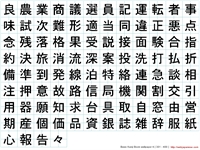
Strategies for Learning Kanji
Important Notice: Our web hosting provider recently started charging us for additional visits, which was unexpected. In response, we're seeking donations. Depending on the situation, we may explore different monetization options for our Community and Expert Contributors. It's crucial to provide more returns for their expertise and offer more Expert Validated Answers or AI Validated Answers. Learn more about our hosting issue here.

Strategies for Learning Kanji
You must be logged in to post a comment.
Effectively learning Japanese and developing a level of fluency requires the memorization of anywhere from 1,000 to 2,000 Kanji. Kanji are Chinese characters which represent words by themselves, or are combined in Kanji Compounds or in compounds with Hiragana to form many of the most common verbs and adjectives used in Japanese. Essentially, there are just under 2,000 Kanji used by fluent Japanese speakers, however, in reality not every native-Japanese speaker actually knows that many.
Kanji are difficult even for native-Japanese to learn, and are considered to be one of the most difficult aspects of learning Japanese as a second or foreign language. There are relatively simple Kanji that students of Japanese learn easily, such as 人(person) and 日(day), but then there are more difficult kanji to memorize such as 劇(drama) and 璃(glassy substance).
Just like learning anything that requires memorization, the best way to create a habitual response, in this case recognizing a Kanji to moment you spot it, is to practice. It is at the discretion of the student whether they wish to memorize writing as well as reading and understanding the Kanji, but writing while memorizing will help the student store the Kanji more efficiently in their minds.
Tips for Learning Kanji